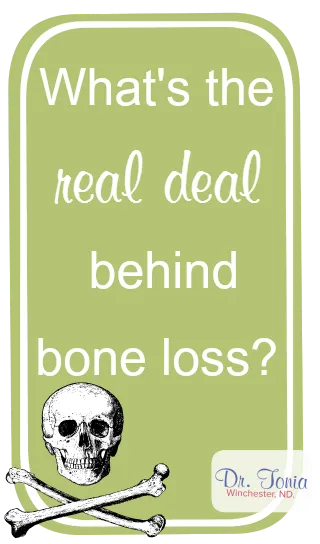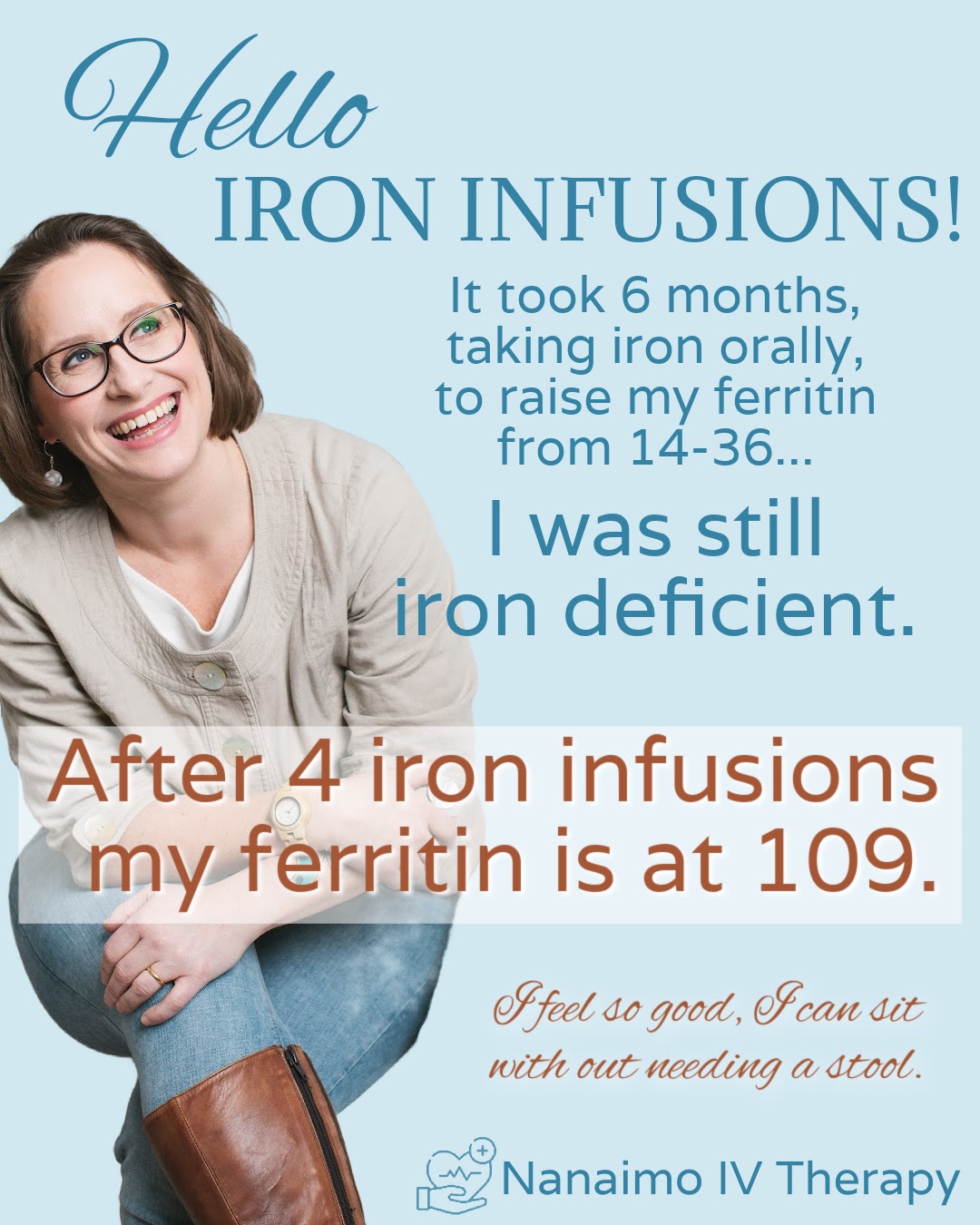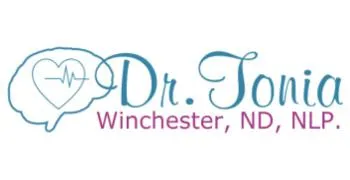Call: 250-753-6322
INTRAVENOUS IV IRON INFUSION THERAPY
For Anemia, Iron Deficiency
(In Nanaimo, BC)
Are You an Eligible Candidate?
OBJECTIVE CRITERIA
What We Measure with Blood Work.
This must be recent, with in 4 weeks.
Iron Deficiency:
Ferrin < 50 ug/L
MICROCYTIC ANEMIA:
MCV < 82 Fl
Low hEMOGLOBIN:
Hemoglobin <125 g/L
Please Note: if you have chronic disease or inflammation, The criteria is:
Ferritin < 100 ug/L with a Transferrin Saturation < 20%
Liver and Kidney functioning well with electrolytes balanced
SUBJECTIVE CRITERIA
Your Symptoms
GENERAL
Fatigue
Dizziness
Shortness of breath
Weakness
Sore muscles
Sore joints
Palpitations
Headaches
Hair loss
Tinnitus
Poor immune function
Weight gain
Pending surgeries
DIGESTIVE
Diarrhea
Constipation
Irritable bowel syndrome (IBS)
Inflammatory Bowel Disease (IBD - Crohn's colitis),
Celiac disease
Candida
SIBO
Food intolerance / allergies
Peptic ulcers
Duodenal ulcers
Vegan
Vegetarian
Nervous / Hormonal
Brain fog
Poor Memory
Restless legs
Anxiety
Depression
Sleep disturbances
Preconception
Pregnancy
Post Partum
Heavy Periods
Fibroids
Hypothyroidism
Call: 250-753-6322
** ^^ This button will take you to calendar with the "Iron infusion consult and treatment" selected. This will ensure we have enough time to do both. Please only book this if you already have your blood work complete. (If you have your blood work already please email it ahead of time).
GEtting started - what you need IN THREE STEPS
IV IRON INFUSION PROGRAM & COSTS
1. BLOOD WORK
COST: $0 - 120 - $240
To be eligible for IV iron infusions I need to see recent bloodwork (taken with in the last 4 weeks)
You can either do this through your GP or Nurse practitioner or through me (billed privately). See below.
I need to see the following (costs if billed privately through my clinic):
Hematology Panel $120 - which includes complete blood count, differential, iron, transferrin saturation, and ferritin. (No fasting required).
Comprehensive Panel $240 - "Hematology Panel" above, plus liver & kidney function, electrolytes, blood glucose, cholesterol, etc. (Fasting preferred). This is a great option if you haven't had any blood work down in a year or so.
2. INJECTION CONSULT
COST: $180
TIME: 45 minutes
Because... safety first.
Before you are eligible for IV iron therapy we need to have a consult so I can understand the full history and your goals with iron infusion therapy.
We'll review your blood work and do any relevant physical exams (blood pressure for example). If it's warranted and safe to do so, and we have enough time allotted ** we can do the first iron infusion that day or book you back in to begin.
Please come to your appointment fed and hydrated.
** ^^ This button will take you to calendar with the "Iron infusion consult and treatment" selected. This will ensure we have enough time to do both. Please only book this option if you have your blood work complete. If not see above.
3. TREATMENTS
COST: $200 x 4
TIME: 45 Minutes
I use Venofer (iron sucrose) as it comes with the lowest risk and best safety profile (for a clinic my size).
I recommend weekly infusions for a total of 4 treatments. Each week your IV will contain up to 100 mg of iron.
Your first treatment might be a modified dose, depending on what I learn in your injection consult.
Most see clinical improvements between 3 and 21 days after.
We typically see ferritin increase by 10-15 points for each 100 mg of iron administered (less if anemic).
We will rerun the Iron Panel and CBC approximately 4-5 weeks after your last treatment.
Please come to your appointment fed and hydrated.
Call: 250-753-6322
HAPPY BODIES. HAPPY PEOPLE.
IRON IV INFUSIONS
& ANEMIA POSTS:

What's Really Behind Bone Loss
In my head, I've been constructing a revamp of an article I wrote for the Plan Facebook page a few weeks back. I wrote it at the time because that week 3 patients asked me about calcium supplementation after seeing a story CBC shared about how it can do more harm than good.
Truthfully this is not new information - the study referenced in the story was a review of 59 OTHER studies.
Why the media was glomming on to it at the time, I don't know. My naturopathic colleagues and I have been aware of this information for a while - I don't even sell any calcium in my clinic!
The thing that pushed me get my article revamp on was this hilarious story from last weekend. This is just too good. I really can't make this stuff up.
My husband and I had been out at a comedy show, and afterwards we were hungry. We live in a pretty sleepy town and there was just a couple places where the kitchen would still be open, so we popped into one our local watering / feeding holes.
We were sitting beside this group of drunk-ish, young men discussing epigenetics (the study of how our environment dictates which genes are expressed in our bodies - one of my favorite topics.)
I phased in and out of listening to their conversation enjoying their liquor-induced ramblings.
Just as we were wrapping up and paying our bill, I heard, "Osteoblasts build the bones... and I think... and the other ones... the osteocytes are the ones that break down bone." All the other heads around their table nodded in agreement.
I made a face.
My husband said, "Why are you making a face?"
"They don't have the facts right." He shrugged - couldn't care less. But gosh! I love a good lesson.
As we walked passed their table I leaned in and said, "OsteoCLASTS is the word you're looking for. Osteocytes are normal bone cells. Osteoblasts build those up, osteoclasts break them down."
They were thrilled. "RIGHT ON!!! That's totally it!!" High fives all around. I never thought bone health and science vocabulary could be so festive and boisterous!
And here we are. This article. The revamp.
Back to Calcium Supplementation.
When you take calcium as a supplement you put yourself at risk for heart attack, stroke, and kidney stones as it gets deposited in muscles and other soft tissues.
And despite these risks, the osteoporosis outcomes are not changed by calcium - it doesn't build bone mass. The epidemiological data is telling here. North Americans have the highest rates of osteoporosis in the world and also the highest dairy consumption rate. No longer can we believe that milk "does a body good." This isn't meant to be a rant about dairy (if it is friendly for you AWESOME)!
Osteoporosis is NOT a calcium deficiency disease. It's related to a delicate biochemical imbalance of hormones and acidity / alkalinity in the body.
I just want to be clear that when it comes to bone health, the answer isn't in a supplement (at least not long term).
Diet and Inflammation.
Preventing bone loss and promoting bone health is about eating a low-reactive diet filled with nutritious foods that you and your body love!
The decreased inflammation (aka return to health) is the perfect climate to put calcium into your bones and keep it there. In other words you stimulate osteoblast activity - supporting the health and structure of the osteocytes.
If you eat heavily processed or reactive foods it creates acidity in the body which needs to be buffered. The best way the body can do this is pull calcium and other minerals OUT OF BONES. Here those darned osteoclasts stimulate the breakdown of the osteocytes releasing the precious acid-buffering minerals. Not what we want.
Plus the amount and quality of calcium you get when eating a low-reactive, nutritious diet from nuts, seeds and greens is far better absorbed and usable by bones than any supplement or source of dairy.
Exercise and Sunshine.
Besides eating your friendly foods, the next best thing you can do for your bone health is get weight-bearing exercise (of course in a form, duration and intensity your body loves.)
Bones are not dead, hard tissue, but quite alive and constantly remodeling to adapt to different movements. The bare bones of it (pun intended) is that more movement means better, stronger bones (more osteoblasat activity).
And when that active lifestyle is out side and you're exposed to all that wonderful natural Vitamin D from the sun? Even better osteoblastic activity.
Depending on where you live, Vitamin D supplementation is something I might recommend for certain periods of the year. Like fall. And winter.
Sedentary lifestyle? Osteoclasts. Bone break down. Booo-urns.
Stress. And Managing It.
Lastly, the other major factor that will contribute to bone loss is stress. Cortisol is a catabolic hormone - it breaks down body tissue instead of building it up (anabolic activity).
It will also pull minerals out of bone (those silly osteoclasts again). Make sure you're doing your best to cut back on sources of stress, and incorporate stress-busting activities like deep breathing, yoga, and the right exercise for you.
There you have it! The real reason behind osteopenia and osteoporosis.
Are you at risk?
Here are 2 quick assessments to figure out if you're at risk (besides the lifestyle behaviours mentioned above).
Risk of Having Osteoporosis:
The first is simple. You minus your weight in kilograms from your age.
AGE – WEIGHT (KG) = your risk factor. Here's how it breaks down:
If the number you got is greater than 20, your risk of having low bone mineral density (BMD) is 50-60%
If your number is between 0-20, then your risk is 15—20%
If your number is less than 0, you have a less than 5% chance of osteoporosis.
5 Year Chance of Fractures (with out knowing your BMD):
However it's not all about the BMD. It is all about the fracture risk - which is related to the chance of falling, and lifestyle factors.
Step 1 (baseline):
For age 65-69 years your:
Chance of non-vertebral fracture (wrist for example) - 10%
Chance of vertebral fracture - 1%
Chance of hip fracture - 0.5%
Step 2 (risk factors):
For each of the factors below add the following percent to the baseline percent:
every 5 year increment above 69 years of age.
history of broken bones after age 50.
mother with hip fracture.
smoking.
being less than 125 pounds
Add:
3% for non vertebral factors
2% for vertebral fractures
and 1% for hip fractures.
For example:
A 74 year old female with a fracture at age 65, weighing 115 pounds. Her risk of vertebral fracture would be 7%.
Does that make sense?
Lets Summarize:
Don't trust drunk guys are telling the truth or using the right words.
Eat a plant based diet that full of foods that work for YOUR body chemistry.
Exercise, in a way that is also right for your body.
Ideally outside when you can.
If you can't, consider supplementing Vitamin D.
Actively reduce and manage stress.
Check your risk factors.
And bingo, bango, bone-grow! You get to enjoy your healthy, happy bones as they help you do what you love for decades.
To your healthy, thriving, delightful life!
BINGEABLE YOUTUBE PLAYLIST:
Dr. Tonia Winchester, ND, BSc, NLP | Naturopathic Doctor | IV Nutrient Therapist
ADDRESS: 975 Terminal Avenue North, Nanaimo, BC V9S 4K3 | PHONE: (250) 753-6322
HOURS: Tuesdays 9:30-5:30 | Wednesdays 9:30-5:30 pm | Occasional Monday and Friday Mornings 8:30 - 12:45 pm
FOR SUPPORT ISSUES OR QUESTIONS, PLEASE EMAIL: [email protected]
Copyright @2022 · 2025 - Tonia Winchester · All Rights Reserved
This site is not a part of the Facebook website or Facebook Inc. Additionally, this site is NOT endorsed by Facebook in any way. FACEBOOK is a trademark of FACEBOOK, Inc.





